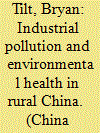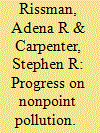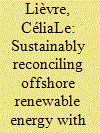| Srl | Item |
| 1 |
ID:
121204


|
|
|
|
|
| Publication |
2013.
|
| Summary/Abstract |
After more than three decades of extremely rapid industrial growth, China faces an environmental public health crisis. In this article, I examine pollution in the rural industrial sector and its implications for community health. Drawing on recent ethnographic research in an industrial township in rural Sichuan, including interviews with government officials, environmental regulators, industrial workers and local residents, I explore how community members understand the linkages between air and water pollution from nearby factories and their health and well-being. The article has two main goals. The first is to examine the various ways in which uncertainty about pollution sources, about the severity of pollution levels and about the links between pollution and human health shapes villagers' experiences of pollution on a day-to-day basis. The second goal is to examine the rising trend of "individualization" taking place in China today and explore how this process is related to people's experiences of toxic exposure. I consider the implications of this trend for how social scientists should approach the study of environmental illness in contemporary China.
|
|
|
|
|
|
|
|
|
|
|
|
|
|
|
|
| 2 |
ID:
139818


|
|
|
|
|
| Summary/Abstract |
Nonpoint source pollution is the runoff of pollutants (including soil and nutrients) from agricultural, urban, and other lands (as opposed to point source pollution, which comes directly from one outlet). Many efforts have been made to combat both types of pollution, so why are we making so little progress in improving water quality by reducing runoff of soil and nutrients into lakes and rivers? This essay examines the challenges inherent in: 1) producing science to predict and assess nonpoint management and policy effectiveness; and 2) using science for management and policy-making. Barriers to demonstrating causality include few experimental designs, different spatial scales for behaviors and measured outcomes, and lags between when policies are enacted and when their effects are seen. Primary obstacles to using science as evidence in nonpoint policy include disagreements about values and preferences, disputes over validity of assumptions, and institutional barriers to reconciling the supply and demand for science. We will illustrate some of these challenges and present possible solutions using examples from the Yahara Watershed in Wisconsin. Overcoming the barriers to nonpoint-pollution prevention may require policy-makers to gain a better understanding of existing scientific knowledge and act to protect public values in the face of remaining scientific uncertainty.
|
|
|
|
|
|
|
|
|
|
|
|
|
|
|
|
| 3 |
ID:
166567


|
|
|
|
|
| Summary/Abstract |
The nascent nature of offshore renewable energy (ORE) technologies coupled with the existence of considerable data gaps and uncertainty on the receiving marine environment demands a paradigm shift in our approach to assessing and managing the impacts of the ORE sector on marine Natura 2000 sites. This paper investigates how the ecosystem-based principles of resilience and adaptive management can be best applied under the appropriate assessment process of the Habitats Directive to reconcile the increasing demand for offshore renewables and biodiversity conservation. In so doing, it challenges the strict interpretation of the precautionary principle which has been crystallised by the EU judiciary under the regime of Article 6(3) of the Habitats Directive and suggests embracing adaptive management as a better methodology to enhance the outcomes of the appropriate assessment in the face of uncertain impacts on Natura 2000 sites and their qualifying features. The aim of this study is solution-based: it seeks to improve the implementation of the assessment procedure of the Habitats Directive before it truly becomes an ‘obstacle course’ for offshore renewable energy developers.
|
|
|
|
|
|
|
|
|
|
|
|
|
|
|
|